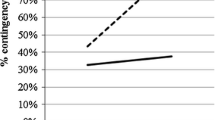Abstract
This paper discusses a case study that investigated situational mechanisms of peer group interaction in collaborative activity. Its goal was to highlight the processes and conditions for meaning-making and to characterise the complex relations of social and cognitive processes emerging in peer-mediated collaborative learning. The pedagogical framework derives from situated views of cognition which aim to engage the learner in activities which encourage problem posing and solving, negotiation and knowledge construction. Twenty 12 year-olds participated in the study. Each student worked in solo and in dyadic conditions on two tasks from their mathematics and language curriculum. Data were gathered by means of videotapes, direct observations, transcriptions, stimulated recall interviews, questionnaires and evaluations of the students’ task productions. Social interaction was analysed at a micro-analytic level within a three-dintensional analytic framework focusing on the communicative function, the nature of collaboration and cognitive processes. The results highlight the interactional and discursive processes inherent in peer-mediated collaborative learning and reveal situational features of students’ social activity which either support or inhibit successful collaboration. The ways in which the logic of peer interaction is reciprocally established in students’ evolving interactions and is shaped by their social and cognitive activity is highlighted. The results inaicate that the complexity and openness of the task, student initiation in meaning-making, and the opportunity to use different semiotic tools are important for supporting dialogic meaning-making in solo and in collaborative activity.
Similar content being viewed by others
References
Barnes, D., & Todd, F. (1995).Communication and learning revisited, making meaning through talk. Portsmouth, NH: Boynton/Cook Publishers Heinemann.
Brown, J.S., Collins, A., & Duguid, P. (1989). Situated cognition and the culture of learning.Educational Researcher, 18, 32–42.
Bruner, J. (1990).Acts of meaning. Cambridge: Harvard University Press.
Cobb, P., & Bowers, J. (1999). Cognitive and situated learning perspectives in theory and practice.Educational Researcher, 28, 4–15.
Cohen, E. (1994). Restructuring the classroom: Conditions for productive small groups.Review of Educational Research, 64, 1–35.
Cole, M. (1996).Culture in mind. Cambridge, MA: Harvard University Press.
Colins, A., Brown, J.S., & Newman, S.E. (1989). Cognitive apprenticeship: Teaching the crafts of reading, writing and mathematics. In L.B. Resnick (Ed.),Knowing, Learning and Instruction: Essays in Honor of Robert Glaser (pp. 453–494). Hillsdale, NJ: Lawrence Erlbaum Associates.
Fourlas, G., & Wray, D. (1990). Children’s oral language: A comparison of two classroom organisational systems. In D. Wray (Ed.),Emerging partnerships, Current research in language and literacy (pp. 76–86). Clevedon: Multilingual Matters Ltd.
Goldman, S.R. (1997). Learning from text: Reflections on the past and suggestions for the future.Discourse Processes, 23, 357–398.
Green, J., & Mayer, L. (1991). The embeddedness of reading in classrom life: Reading as a situated process. In C. Baker & A. Luke (Eds.),Toward a critical sociology of reading pedagogy (pp. 141–160). Amsterdam: Benjamins Publishing Company.
Green, J., & Wallat, C. (1981). Mapping instructional conversations — A sociolinguistic ethnography. In J. Green & C. Wallat (Eds.),Ethnography and language in educational settings (pp. 161–228), Norwood: Ablex Publishing Corporation.
Grossen, M. (1994). Theoretical and methodological consequences of a change in the unit of analysis for the study of peer interactions in a problem solving situation.European Journal of Psychology of Education, 11, 159–173.
Harré, R., & Gillett, G. (1994).The discursive mind. London: Sage Publications.
Kumpulainen, K. (1994).The nature of children’s oral language interactions during collaborative writing experience at the computer. (Unpublished doctoral dissertation). Exeter: University of Exeter.
Kumpulainen, K. (1996). The nature of peer interaction in the social context created by the use of word processors.Learning and Instruction, 6, 243–261.
Kumpulainen, K., & Kaartinen, S. (1999, August).Thinking geometry — The interplay between everyday and spatial explanations in peer problem solving. A paper presented at the Annual Conference of the European Association for Research on Learning and Instruction (EARLI), Göteborg, Sweden.
Kumpulainen, K., & Mutanen, M. (1998). Collaborative practice of science construction in a computer-based.Computers and Education, 30, 75–85.
Kumpulainen, K., & Mutanen, M. (1999). The situated dynamics of peer group interaction: an introduction to an analytic framework.Learning and Instruction, 9, 449–473.
Lave, J., & Wenger, E. (1991).Situated learning. Legitimate peripheral participation. Cambridge: Cambridge University Press.
Mercer, N. (1996). The quality of talk in children’s collaborative activity in the classroom.Learning and Instruction, 6, 359–377.
Resnick, L.B., Levine, J.M., & Teasley, S.D. (Eds.). (1991).Perspectives on socially shared cognition. Washington: American Psychological Association.
Rogoff, B. (1990).Apprenticeship in thinking: Cognitive development in social context. New York: Oxford University Press.
Tuyay, S., Jenrings, L., & Dixon, C. (1995). Classroom discourse and opportunities to learn: An ethnographic study of knowledge construction in a bilingual third grade classroom. In R. Durán (Ed.),Discourse processes (Literacy among latinos: Focus on school contexts), 19, 75–110.
Vion, R. (1992).La communication verbale, Analyse des interactions. Paris: Hachette.
Vosniadou, S. (1996). Towards a revised cognitive psychology for new advances in learning and instruction.Learning and Instraction, 6, 95–109.
Vygotsky, L.S. (1962).Thought and language (E. Hanfmann & G. Vakar, Eds. and Trans.), Cambridge, MA: MIT Press.
Vygotsky, L.S. (1978).Mind in society: The development of higher mental processes (M. Cole, V. John-Steiner, & E. Souberman, Eds.). Cambridge, MA: Harvard University Press.
Wertsch, J. (1991).Voices of the mind: A sociocultural approach to mediated action. Cambridge, MA: Harvard University Press.
Author information
Authors and Affiliations
Additional information
The research reported in this paper was supported by the Academy of Finland (Project no. 41979).
Rights and permissions
About this article
Cite this article
Kumpulainen, K., Kaartinen, S. Situational mechanisms of peer group interaction in collaborative meaning-making: Processes and conditions for learning. Eur J Psychol Educ 15, 431–454 (2000). https://doi.org/10.1007/BF03172986
Received:
Issue Date:
DOI: https://doi.org/10.1007/BF03172986




